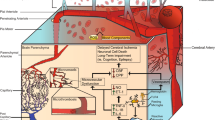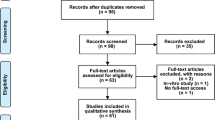Abstract
Introduction
Aneurysmal subarachnoid hemorrhage (SAH) has a poor outcome, particularly attributed to progressive injury after the initial incident. Several studies suggest a critical role for inflammation in lesion progression after SAH. Our goal was to test whether treatment with anti-inflammatory interferon-β, which has shown promise as a therapeutic agent in experimental ischaemic stroke, can protect the brain after SAH.
Methods
SAH was induced in adult male Wistar rats by puncturing the intracranial bifurcation of the right internal carotid artery. Treatment effects of daily interferon-β (n = 16) or vehicle (n = 14) injections were serially evaluated with multiparametric MRI and behavioral tests from day 0 to 7, in compliance with recent recommendations for pre-clinical drug testing. Outcome measures included neurological status, brain lesion volume, blood–brain barrier (BBB) leakage, and levels of inflammatory markers.
Results
In animals that survived up to 7 days post-SAH, we found no significant differences between vehicle- and interferon-β-treated animals with respect to final neurological score (14.3 ± 1.0 vs. 13.0 ± 2.2), brain lesion size on T2-weighted MR images (59 ± 83 vs. 124 ± 99 mm3), BBB leakage (0.26 ± 0.05 vs. 0.22 ± 0.08 contrast-induced relative MR signal change), upregulation of brain RNA for cytokines, chemokines and cell adhesion molecules, and increased neutrophil activation.
Conclusions
In contrast to previously published findings in experimental ischemic stroke models, interferon-β has no clear efficacy to protect the brain after SAH. In line with recent highlighting of the significance of negative findings, our data currently do not recommend clinical testing of interferon-β to prevent neurological damage in SAH patients.






Similar content being viewed by others
References
van Gijn J, Kerr RS, Rinkel GJ. Subarachnoid haemorrhage. Lancet. 2007;369:306–18.
Pluta RM, Zhang JH. Metamorphosis of subarachnoid hemorrhage research: from delayed vasospasm to early brain injury. Mol Neurobiol. 2011;43:27–40.
Provencio JJ, Vora N. Subarachnoid hemorrhage and inflammation: bench to bedside and back. Semin Neurol. 2005;25:435–44.
Chaichana KL, Pradilla G, Huang J, Tamargo RJ. Role of inflammation (leukocyte-endothelial cell interactions) in vasospasm after subarachnoid hemorrhage. World Neurosurg. 2010;73:22–41.
Arnason BG. Interferon beta in multiple sclerosis. Clin Immunol Immunopathol. 1996;81:1–11.
Kraus J, Oschmann P. The impact of interferon-beta treatment on the blood–brain barrier. Drug Discov Today. 2006;11:755–62.
Veldhuis WB, Derksen JW, Floris S, et al. Interferon-beta blocks infiltration of inflammatory cells and reduces infarct volume after ischemic stroke in the rat. J Cereb Blood Flow Metab. 2003;23:1029–39.
Marsh B, Stevens SL, Gopalan B, et al. Systemic lipopolysaccharide protects the brain from ischemic injury by reprogramming the response of the brain to stroke: a critical role for irf3. J Neurosci. 2009;29:9839–49.
van den Bergh WM, Schepers J, Veldhuis WB, Nicolay K, Tulleken CA, Rinkel GJ. Magnetic resonance imaging in experimental subarachnoid haemorrhage. Acta Neurochir (Wien). 2005;147:977–83.
Olsson T, Kelic S, Edlund C, et al. Neuronal interferon-gamma immunoreactive molecule: bioactivities and purification. Eur J Immunol. 1994;24:308–14.
Floris S, Ruuls SR, Wierinckx A, et al. Interferon-beta directly influences monocyte infiltration into the central nervous system. J Neuroimmunol. 2002;127:69–79.
Veldhuis WB, Floris S, van der Meide PH, et al. Interferon-beta prevents cytokine-induced neutrophil infiltration and attenuates blood–brain barrier disruption. J Cereb Blood Flow Metab. 2003;23:1060–9.
Sugawara T, Ayer R, Jadhav V, Zhang JH. A new grading system evaluating bleeding scale in filament perforation subarachnoid hemorrhage rat model. J Neurosci Methods. 2008;167:327–34.
Yonemori F, Yamaguchi T, Yamada H, Tamura A. Evaluation of a motor deficit after chronic focal cerebral ischemia in rats. J Cereb Blood Flow Metab. 1998;18:1099–106.
Werner U, Szelenyi I. Measurement of mpo activity as model for detection of granulocyte infiltration in different tissues. Agents Actions 1992;Spec No:C101–C103.
Cobelens PM, van Putte BP, Kavelaars A, Heijnen CJ, Kesecioglu J. Inflammatory consequences of lung ischemia-reperfusion injury and low-pressure ventilation. J Surg Res. 2009;153:295–301.
Macleod MR, Fisher M, O’Collins V, et al. Good laboratory practice: preventing introduction of bias at the bench. Stroke. 2009;40:e50–2.
Lee JY, Sagher O, Keep R, Hua Y, Xi G. Comparison of experimental rat models of early brain injury after subarachnoid hemorrhage. Neurosurgery. 2009;65:331–43.
Fisher M, Feuerstein G, Howells DW, et al. Update of the stroke therapy academic industry roundtable preclinical recommendations. Stroke. 2009;40:2244–50.
van der Worp HB, Howells DW, Sena ES, et al. Can animal models of disease reliably inform human studies? PLoS Med. 2010;7:e1000245.
Busch E, Beaulieu C, de Crespigny A, Moseley ME. Diffusion MR imaging during acute subarachnoid hemorrhage in rats. Stroke. 1998;29:2155–61.
Cobelens PM, Tiebosch IA, Dijkhuizen RM, et al. Interferon-beta attenuates lung inflammation following experimental subarachnoid hemorrhage. Crit Care. 2010;14:R157.
Maier CM, Yu F, Nishi T, Lathrop SJ, Chan PH. Interferon-beta fails to protect in a model of transient focal stroke. Stroke. 2006;37:1116–9.
Tremlett H, Oger J. Hepatic injury, liver monitoring and the beta-interferons for multiple sclerosis. J Neurol. 2004;251:1297–303.
Dirnagl U, Lauritzen M. Fighting publication bias: introducing the negative results section. J Cereb Blood Flow Metab. 2010;30:1263–4.
Acknowledgments
This research was conducted with financial aid from The Netherlands Brain Foundation (15F07(2)0.08), The Netherlands Heart Foundation (2005B156) and the University Medical Centre Utrecht. Interferon-β was provided by U-CyTech.
Author information
Authors and Affiliations
Corresponding author
Rights and permissions
About this article
Cite this article
Tiebosch, I.A.C.W., Dijkhuizen, R.M., Cobelens, P.M. et al. Effect of Interferon-β on Neuroinflammation, Brain Injury and Neurological Outcome After Experimental Subarachnoid Hemorrhage. Neurocrit Care 18, 96–105 (2013). https://doi.org/10.1007/s12028-012-9692-2
Published:
Issue Date:
DOI: https://doi.org/10.1007/s12028-012-9692-2




